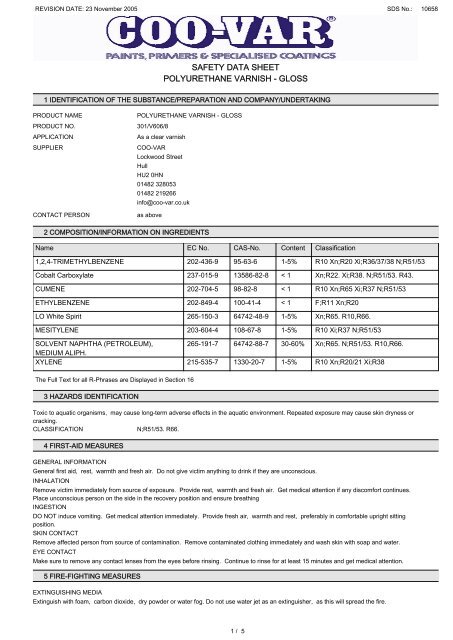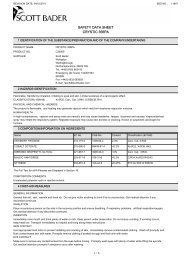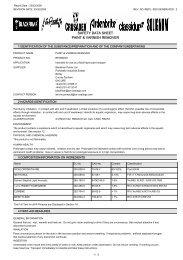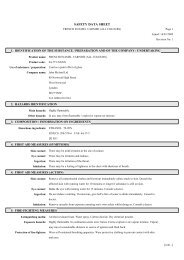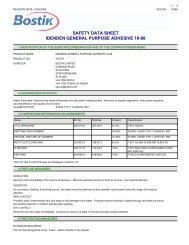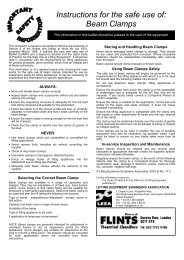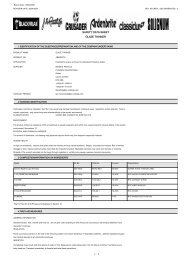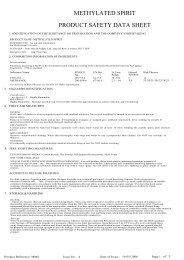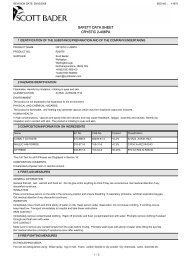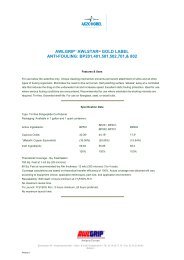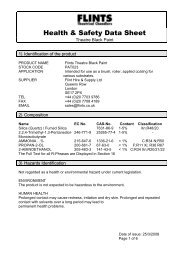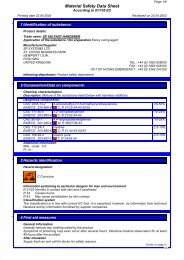safety data sheet polyurethane varnish - gloss - Flint Hire & Supply
safety data sheet polyurethane varnish - gloss - Flint Hire & Supply
safety data sheet polyurethane varnish - gloss - Flint Hire & Supply
Create successful ePaper yourself
Turn your PDF publications into a flip-book with our unique Google optimized e-Paper software.
REVISION DATE: 23 November 2005 SDS No.: 10658<br />
SAFETY DATA SHEET<br />
POLYURETHANE VARNISH - GLOSS<br />
1 IDENTIFICATION OF THE SUBSTANCE/PREPARATION AND COMPANY/UNDERTAKING<br />
PRODUCT NAME<br />
PRODUCT NO.<br />
APPLICATION<br />
SUPPLIER<br />
CONTACT PERSON<br />
POLYURETHANE VARNISH - GLOSS<br />
301/V606/8<br />
As a clear <strong>varnish</strong><br />
COO-VAR<br />
Lockwood Street<br />
Hull<br />
HU2 0HN<br />
01482 328053<br />
01482 219266<br />
info@coo-var.co.uk<br />
as above<br />
2 COMPOSITION/INFORMATION ON INGREDIENTS<br />
Name EC No. CAS-No. Content Classification<br />
1,2,4-TRIMETHYLBENZENE 202-436-9 95-63-6 1-5% R10 Xn;R20 Xi;R36/37/38 N;R51/53<br />
Cobalt Carboxylate 237-015-9 13586-82-8 < 1 Xn;R22. Xi;R38. N;R51/53. R43.<br />
CUMENE 202-704-5 98-82-8 < 1 R10 Xn;R65 Xi;R37 N;R51/53<br />
ETHYLBENZENE 202-849-4 100-41-4 < 1 F;R11 Xn;R20<br />
LO White Spirit 265-150-3 64742-48-9 1-5% Xn;R65. R10,R66.<br />
MESITYLENE 203-604-4 108-67-8 1-5% R10 Xi;R37 N;R51/53<br />
SOLVENT NAPHTHA (PETROLEUM), 265-191-7 64742-88-7 30-60% Xn;R65. N;R51/53. R10,R66.<br />
MEDIUM ALIPH.<br />
XYLENE 215-535-7 1330-20-7 1-5% R10 Xn;R20/21 Xi;R38<br />
The Full Text for all R-Phrases are Displayed in Section 16<br />
3 HAZARDS IDENTIFICATION<br />
Toxic to aquatic organisms, may cause long-term adverse effects in the aquatic environment. Repeated exposure may cause skin dryness or<br />
cracking.<br />
CLASSIFICATION N;R51/53. R66.<br />
4 FIRST-AID MEASURES<br />
GENERAL INFORMATION<br />
General first aid, rest, warmth and fresh air. Do not give victim anything to drink if they are unconscious.<br />
INHALATION<br />
Remove victim immediately from source of exposure. Provide rest, warmth and fresh air. Get medical attention if any discomfort continues.<br />
Place unconscious person on the side in the recovery position and ensure breathing<br />
INGESTION<br />
DO NOT induce vomiting. Get medical attention immediately. Provide fresh air, warmth and rest, preferably in comfortable upright sitting<br />
position.<br />
SKIN CONTACT<br />
Remove affected person from source of contamination. Remove contaminated clothing immediately and wash skin with soap and water.<br />
EYE CONTACT<br />
Make sure to remove any contact lenses from the eyes before rinsing. Continue to rinse for at least 15 minutes and get medical attention.<br />
5 FIRE-FIGHTING MEASURES<br />
EXTINGUISHING MEDIA<br />
Extinguish with foam, carbon dioxide, dry powder or water fog. Do not use water jet as an extinguisher, as this will spread the fire.<br />
1 / 5
REVISION DATE: 23 November 2005 SDS No.: 10658<br />
SPECIAL FIRE FIGHTING PROCEDURES<br />
POLYURETHANE VARNISH - GLOSS<br />
Be aware of danger for fire to re-start. Cool containers exposed to flames with water until well after the fire is out. Do not allow runoff to<br />
sewer, waterway or ground.<br />
UNUSUAL FIRE & EXPLOSION HAZARDS<br />
FLAMMABLE. Solvent vapours may form explosive mixtures with air.<br />
SPECIFIC HAZARDS<br />
By heating and fire, harmful vapours/gases may be formed.<br />
PROTECTIVE MEASURES IN FIRE<br />
Selection of respiratory protection for fire fighting: follow the general fire precautions indicated in the workplace.<br />
6 ACCIDENTAL RELEASE MEASURES<br />
PERSONAL PRECAUTIONS<br />
Avoid inhalation of vapours and contact with skin and eyes. Provide adequate ventilation. Do not smoke, use naked flames or other sources<br />
of ignition. Ensure suitable personal protection (including respiratory protection) during removal of spillages in a confined area.<br />
ENVIRONMENTAL PRECAUTIONS<br />
Do not discharge into drains, water courses or onto the ground. Contain spillages with sand, earth or any suitable adsorbent material.<br />
Spillages or uncontrolled discharges into watercourses must be IMMEDIATELY alerted to the Environmental Agency or other appropriate<br />
regulatory body.<br />
SPILL CLEAN UP METHODS<br />
Extinguish all ignition sources. Avoid sparks, flames, heat and smoking. Ventilate. Should be prevented from entering drains. Absorb in<br />
vermiculite, dry sand or earth and place into containers. Collect spillage in containers, seal securely and deliver for disposal according to<br />
local regulations.<br />
7 HANDLING AND STORAGE<br />
USAGE PRECAUTIONS<br />
Observe workplace exposure limits and minimise the risk of inhalation of vapours and mist. Keep away from heat, sparks and open flame.<br />
Avoid spilling, skin and eye contact. Ventilate well, avoid breathing vapours. Use approved respirator if air contamination is above<br />
accepted level. Do not eat, drink or smoke when using the product.<br />
USAGE DESCRIPTION<br />
Ensure that waste and contaminated materials are collected and removed from the work area as soon as possible in a suitably labelled<br />
container<br />
STORAGE PRECAUTIONS<br />
Store in closed original container at temperatures between 5°C and 25°C. Keep away from heat, sparks and open flame. Keep containers<br />
tightly closed. Keep upright. Store separated from: Oxidising material. Alkalies. Acids.<br />
STORAGE CLASS<br />
Flammable liquid storage.<br />
8 EXPOSURE CONTROLS/PERSONAL PROTECTION<br />
Name<br />
XYLENE<br />
ETHYLBENZENE<br />
CUMENE<br />
1,2,4-TRIMETHYLBENZENE<br />
Std LT - ppm LT - mg/m3 ST - ppm ST - mg/m3<br />
WEL 50 ppm(Sk) 220 mg/m3(Sk) 100 ppm(Sk) 441 mg/m3(Sk)<br />
WEL 100 ppm(Sk) 441 mg/m3(Sk) 125 ppm(Sk) 552 mg/m3(Sk)<br />
WEL 25 ppm(Sk) 125 mg/m3(Sk) 50 ppm(Sk) 250 mg/m3(Sk)<br />
WEL<br />
INGREDIENT COMMENTS<br />
WEL = Workplace Exposure Limits<br />
PROTECTIVE EQUIPMENT<br />
ENGINEERING MEASURES<br />
Provide adequate ventilation, including appropriate local extraction, to ensure that the defined workplace exposure limit is not exceeded.<br />
RESPIRATORY EQUIPMENT<br />
No specific recommendation made, but respiratory protection must be used if the general level exceeds the Recommended Workplace<br />
Exposure Limit.<br />
HAND PROTECTION<br />
Use suitable protective gloves if risk of skin contact. The most suitable glove must be chosen in consultation with the gloves supplier, who<br />
can inform about the breakthrough time of the glove material. Barrier cream applied before work may make it easier to clean the skin after<br />
exposure, but does not prevent absorption through the skin.<br />
2 / 5
REVISION DATE: 23 November 2005 SDS No.: 10658<br />
POLYURETHANE VARNISH - GLOSS<br />
EYE PROTECTION<br />
Wear splash-proof eye goggles to prevent any possibility of eye contact.<br />
OTHER PROTECTION<br />
Wear appropriate clothing to prevent reasonably probable skin contact.<br />
HYGIENE MEASURES<br />
No specific hygiene procedures noted, but good personal hygiene practices are always advisable, especially when working with chemicals.<br />
9 PHYSICAL AND CHEMICAL PROPERTIES<br />
APPEARANCE<br />
Thick, cloudy fluid<br />
COLOUR<br />
Colourless<br />
ODOUR<br />
of solvents<br />
SOLUBILITY<br />
Insoluble in water<br />
RELATIVE DENSITY 0.88 @ 20 C VAPOUR DENSITY (air=1) heavier than air<br />
VISCOSITY 2.0 (Rotothinner) Ps @ 25 C FLASH POINT (°C) 39 approx. CC (Closed cup).<br />
FLAMMABILITY LIMIT - LOWER(%) 0.8<br />
10 STABILITY AND REACTIVITY<br />
STABILITY<br />
Stable under normal temperature conditions and recommended use.<br />
CONDITIONS TO AVOID<br />
Avoid heat, flames and other sources of ignition. Avoid contact with acids and oxidising substances.<br />
MATERIALS TO AVOID<br />
Strong alkalies. Strong acids. Strong oxidising substances.<br />
HAZARDOUS DECOMPOSITION PRODUCTS<br />
Thermal decomposition or combustion may liberate carbon oxides and other toxic gases or vapours.<br />
11 TOXICOLOGICAL INFORMATION<br />
INHALATION<br />
Vapour from this chemical can be hazardous when inhaled. Vapour may irritate respiratory system or lungs.<br />
INGESTION<br />
Liquid irritates mucous membranes and may cause abdominal pain if swallowed.<br />
SKIN CONTACT<br />
Acts as a defatting agent on skin. May cause cracking of skin, and eczema. Prolonged or repeated exposure may cause severe irritation.<br />
EYE CONTACT<br />
May cause temporary eye irritation.<br />
HEALTH WARNINGS<br />
This product has low toxicity. Only large volumes may have adverse impact on human health.<br />
MEDICAL CONSIDERATIONS<br />
Skin disorders and allergies. Avoid vomiting and normal rinse of stomach because of risk of aspiration.<br />
12 ECOLOGICAL INFORMATION<br />
ECOTOXICITY<br />
The product contains substances which are toxic to aquatic organisms and which may cause long term adverse effects in the aquatic<br />
environment.<br />
BIOACCUMULATION<br />
The product contains potentially bioaccumulating substances.<br />
DEGRADABILITY<br />
The product is not expected to be biodegradable.<br />
13 DISPOSAL CONSIDERATIONS<br />
GENERAL INFORMATION<br />
Do not allow to enter drains, sewers or watercourses.<br />
DISPOSAL METHODS<br />
Dispose of waste and residues in accordance with local authority requirements.<br />
14 TRANSPORT INFORMATION<br />
3 / 5
REVISION DATE: 23 November 2005 SDS No.: 10658<br />
POLYURETHANE VARNISH - GLOSS<br />
UK ROAD CLASS 3.3<br />
PROPER SHIPPING NAME<br />
ROAD TRANSPORT NOTES<br />
RAIL TRANSPORT NOTES<br />
SEA TRANSPORT NOTES<br />
UN NO. ROAD<br />
ADR CLASS NO.<br />
PAINT PRODUCT<br />
Avoid releasing to the environment.<br />
Avoid releasing to the environment.<br />
Do not release into the environment.<br />
1263<br />
1263<br />
UK ROAD PACK GR.<br />
ADR CLASS<br />
III<br />
Class 3: Flammable liquids.<br />
ADR PACK GROUP<br />
III<br />
HAZARD NO. (ADR)<br />
30 Flammable liquid<br />
(flash-point between 23°C and<br />
61°C, inclusive) or flammable<br />
liquid or solid in the molten state<br />
with a flash-point above 61°C,<br />
heated to a temperature equal<br />
to or above its flash-point, or<br />
self heating liquid.<br />
CEFIC TEC(R) NO. 30GF1-III, 30GF1-sp<br />
UN NO. SEA<br />
1263<br />
IMDG CLASS<br />
EMS<br />
3.3<br />
3-05<br />
IMDG PACK GR.<br />
MARINE POLLUTANT<br />
III<br />
UN NO. AIR 1263<br />
ICAO CLASS<br />
3.3<br />
AIR PACK GR.<br />
15 REGULATORY INFORMATION<br />
LABELLING<br />
III<br />
RISK PHRASES<br />
SAFETY PHRASES<br />
UK REGULATORY REFERENCES<br />
Dangerous for the<br />
environment<br />
R51/53 Toxic to aquatic organisms, may cause long-term adverse effects in the aquatic<br />
environment.<br />
R66<br />
Repeated exposure may cause skin dryness or cracking.<br />
S37<br />
S61<br />
P14<br />
S2<br />
S16<br />
Wear suitable gloves.<br />
Avoid release to the environment. Refer to special instructions/<strong>safety</strong> <strong>data</strong> <strong>sheet</strong>s.<br />
Contains Cobalt Carboxylate. May produce an allergic reaction.<br />
Keep out of the reach of children<br />
Keep away from sources of ignition - No smoking.<br />
S29/56 Do not empty into drains, dispose of this material and its container at hazardous or special<br />
waste collection point.<br />
S46<br />
If swallowed, seek medical advice immediately and show this container or label.<br />
S51<br />
Use only in well-ventilated areas.<br />
Chemicals (Hazard Information & Packaging) Regulations. The Control of Substances Hazardous to Health Regulations 1988. Health and<br />
Safety at Work Act 1974.<br />
ENVIRONMENTAL LISTING<br />
Control of Pollution Act 1974. Rivers (Prevention of Pollution) Act 1961.<br />
EU DIRECTIVES<br />
Dangerous Substance Directive 67/548/EEC. Dangerous Preparations Directive 1999/45/EEC.<br />
4 / 5
REVISION DATE: 23 November 2005 SDS No.: 10658<br />
STATUTORY INSTRUMENTS<br />
POLYURETHANE VARNISH - GLOSS<br />
Chemicals (Hazard Information and Packaging) Regulations. Control of Substances Hazardous to Health.<br />
APPROVED CODE OF PRACTICE<br />
Safety Data Sheets for Substances and Preparations. Classification and Labelling of Substances and Preparations Dangerous for <strong>Supply</strong>.<br />
GUIDANCE NOTES<br />
Workplace Exposure Limits EH40. CHIP for everyone HSG(108).<br />
NATIONAL REGULATIONS<br />
The Chemicals (Hazard Information and Packaging for <strong>Supply</strong>) Regulations 2002. No. 1689. Worplace Exposure Limits 2005 (EH40) Health<br />
and Safety at Work Act (As Amended) 1974 Control of Substances Hazardous to Health Regulations 2002 (as amended) The Carriage of<br />
Dangerous Goods and use of transportable pressure equipment regulations 2004.<br />
16 OTHER INFORMATION<br />
REVISION COMMENTS<br />
Major revision (CHIP3) Revisions to sections: (1), (2), (3), (8), (14), (15), and (16) Revision for WEL(Workplace Exposure Limit) section<br />
8.<br />
ISSUED BY<br />
Technical Dept. (P.E.)<br />
REVISION DATE 23 November 2005<br />
REV. NO./REPL. SDS GENERATED 1 / replaces all previous<br />
SDS NO. 10658<br />
SAFETY DATA SHEET STATUS<br />
Approved.<br />
DATE<br />
SIGNATURE<br />
Date printed _________________<br />
Initials ___________________________<br />
RISK PHRASES IN FULL<br />
R10<br />
R11<br />
R20<br />
R20/21<br />
R22<br />
R36/37/38<br />
R37<br />
R38<br />
R43<br />
R51/53<br />
R65<br />
R66<br />
Flammable.<br />
Highly flammable.<br />
Harmful by inhalation.<br />
Harmful by inhalation and in contact with skin.<br />
Harmful if swallowed.<br />
Irritating to eyes, respiratory system and skin.<br />
Irritating to respiratory system.<br />
Irritating to skin.<br />
May cause sensitisation by skin contact.<br />
Toxic to aquatic organisms, may cause long-term adverse effects in the aquatic environment.<br />
Harmful: may cause lung damage if swallowed.<br />
Repeated exposure may cause skin dryness or cracking.<br />
DISCLAIMER<br />
This information relates only to the specific material designated and may not be valid for such material used in combination with<br />
any other materials or in any process. Such information is, to the best of the company's knowledge and belief, accurate and<br />
reliable as of the date indicated. However, no warranty guarantee or representation is made to its accuracy, reliability or<br />
completeness. It is the user's responsibility to satisfy himself as to the suitability of such information for his own particular use.<br />
5 / 5


